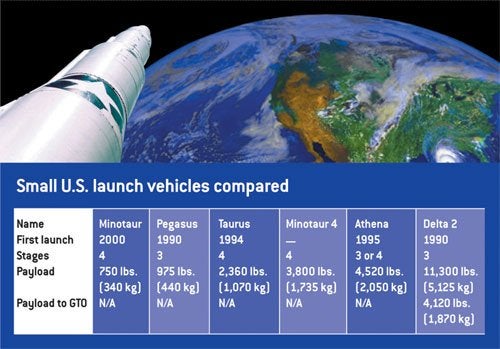However, components from Minute-man missiles now are used to deliver payloads to low Earth orbit (LEO). The 4-stage Minotaur rocket, developed by Orbital Sciences Corporation, uses Minuteman II motors in its first two stages and can loft a 750-pound (340 kilogram) payload into LEO. A more advanced version, called Minotaur 4, will contain elements from decommissioned Peacekeeper missiles and will be able to deliver about five times more mass to LEO.
Getting to the Moon or beyond is, however, currently beyond the ability of launchers based on ballistic missiles. Such a booster would need to deliver its payload so the orbit’s apogee — that is, the farthest point from Earth — reached Geostationary Transfer Orbit (GTO), the starting point for a slow outward spiral to the Moon and elsewhere. The European Space Agency’s 770-pound (350 kg) SMART-1 satellite recently used this approach. Launched as a secondary payload on an Ariane 5 rocket, SMART-1 reached GTO and fired an innovative electric propulsion unit that provided a small but nearly continuous thrust for 13 months. This expanded the spacecraft’s orbit until the Moon’s gravity could capture it.
A Minotaur launch costs about $20 million, which at the moment is about as inexpensive as it gets for putting a payload into orbit. Bear in mind, the launch vehicle is only part of the cost. You still have to pay for contractors — this alone can reach 65 percent of the total cost — as well as fuel, range and ground support, and permits. Low-cost vehicles certainly help, but these other factors play a significant role in setting the minimum cost for placing payloads into orbit.
Bottom line: We can and do use converted missiles to put payloads into LEO. Ultimately, though, we’re limited by the fact that such boosters were designed to loft warheads into suborbital ballistic trajectories, which require much less energy than placing an equivalent weight into Earth orbit. — BILL COOKE, MARSHALL SPACE FLIGHT CENTER, HUNTSVILLE, ALABAMA










